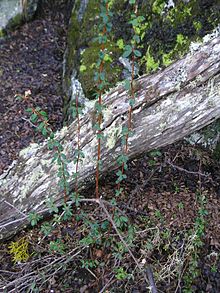Berberis buxifolia
| Berberis microphylla | |
|---|---|
 |
|
| Calafate (Berberis microphylla) | |
| Scientific classification | |
| Kingdom: | Plantae |
| (unranked): | Angiosperms |
| (unranked): | Eudicots |
| Order: | Ranunculales |
| Family: | Berberidaceae |
| Genus: | Berberis |
| Species: | B. microphylla |
| Binomial name | |
|
Berberis microphylla G. Forst. 1789 |
|
| Synonyms | |
|
|
Berberis microphylla, common name Box-leaved Barberry and Magellan Barberry, in Spanish calafate and michay and other names, is an evergreen shrub, with simple, shiny box-like leaves. The Calafate is native to southern Argentina and Chile and is a symbol of Patagonia.
The bush grows to a height of 1.0 to 1.5 m (3 ft 3 in to 4 ft 11 in). It has many arching branches, each covered in many tripartite spines. The bush has many small yellow flowers in summer. Its edible blue-black berries are harvested for jams, but are eaten fresh too - a legend tells that anyone who eats a Calafate berry will be certain to return to Patagonia.
The Calafate is grown commercially for its fruit, potential medical uses and as a garden plant or bonsai. Its wood is used to make a red dye. The cultivar Berberis microphylla 'Nana' is widely available as a garden shrub, and is also used in commercial plantings as a low spiny hedge to discourage intruders, but it does not fruit.
Berberis microphylla should not be confused with Mahonia microphylla T.S.Ying & GR.Long, native to China.
...
Wikipedia
